
Magdeburg is the capital of the German state Saxony-Anhalt. The city is on the Elbe river.

Eisenach is a town in Thuringia, Germany with 42,000 inhabitants, located 50 kilometres west of Erfurt, 70 km southeast of Kassel and 150 km northeast of Frankfurt. It is the main urban centre of western Thuringia and bordering northeastern Hessian regions, situated near the former Inner German border. A major attraction is Wartburg castle, which has been a UNESCO World Heritage Site since 1999.
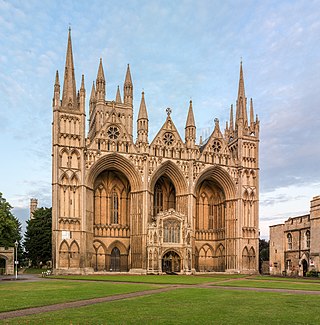
Peterborough Cathedral, properly the Cathedral Church of St Peter, St Paul and St Andrew, and formerly known as Peterborough Abbey or St Peter's Abbey, is a cathedral in Peterborough, Cambridgeshire, in the United Kingdom. The seat of the Anglican Bishop of Peterborough, it is dedicated to the Apostles Saint Peter, Saint Paul, and Saint Andrew, whose statues look down from the three high gables of the West Front. Founded in the Anglo-Saxon period as a minster it became one of England's most important Benedictine abbeys, becoming a cathedral only in 1542. Its architecture is mainly Norman, following a rebuilding in the 12th century. Alongside the cathedrals of Durham and Ely, it is one of the most important 12th-century buildings in England to have remained largely intact, despite extensions and restoration, and is one of the nation's best preserved pre-Reformation abbeys.

Halle (Saale), or simply Halle (German:[ˈhalə]; from the 15th to the 17th century: Hall in Sachsen; until the beginning of the 20th century: Halle an der Saale ; from 1965 to 1995: Halle/Saale), is the largest city of the German state of Saxony-Anhalt. It is the fifth-most populous city in the area of former East Germany after (East) Berlin, Leipzig, Dresden and Chemnitz, as well as the 31st-largest city of Germany. With around 244,000 inhabitants, it is slightly more populous than the state capital, Magdeburg. With Leipzig, the largest city of Saxony, Halle forms the polycentric Leipzig-Halle conurbation. Leipzig/Halle International Airport lies between the two cities, in Schkeuditz. The Leipzig-Halle conurbation is at the heart of the larger Central German Metropolitan Region.

St Martin's Cathedral is a church in Bratislava, Slovakia, and the cathedral of the Archdiocese of Bratislava.
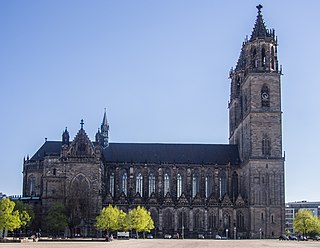
Magdeburg Cathedral, officially called the Cathedral of Saints Maurice and Catherine, is a Protestant cathedral in Germany and the oldest Gothic cathedral in the country. It is the proto-cathedral of the former Prince-Archbishopric of Magdeburg. Today it is the principal church of the Evangelical Church in Central Germany. The south steeple is 99.25 m tall, the north tower 100.98 m, making it one of the tallest cathedrals in eastern Germany. The cathedral is likewise the landmark of Magdeburg, the capital city of the Bundesland of Saxony-Anhalt, and is also home to the grave of Emperor Otto I the Great and his first wife Edith.

Mainz Cathedral or St. Martin's Cathedral is located near the historical center and pedestrianized market square of the city of Mainz, Germany. This 1000-year-old Roman Catholic cathedral is the site of the episcopal see of the Bishop of Mainz.

Romanesque Revival is a style of building employed beginning in the mid-19th century inspired by the 11th- and 12th-century Romanesque architecture. Unlike the historic Romanesque style, Romanesque Revival buildings tended to feature more simplified arches and windows than their historic counterparts.

The Diocese of Magdeburg is a Latin Church diocese of the Catholic Church, located in the German state of Saxony-Anhalt. Its seat is Magdeburg; it is suffragan to the Archdiocese of Paderborn.

The Church of St. Nicholas was a Gothic Revival cathedral that was formerly one of the five Lutheran Hauptkirchen in the city of Hamburg, Germany. The original chapel, a wooden building, was completed in 1195. It was replaced by a brick church in the 14th century, which was eventually destroyed by fire in 1842. The church was completely rebuilt by 1874, and was the tallest building in the world from 1874 to 1876. It was designed by the English architect George Gilbert Scott.
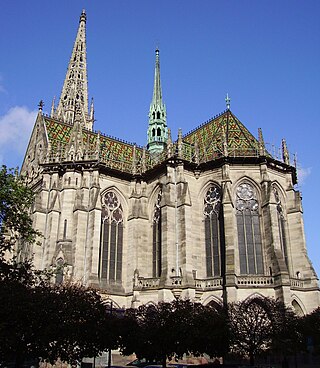
The Gedächtniskirche der Protestation is a United Protestant church of both Lutheran and Reformed confessions in Speyer, Rhineland-Palatinate, Germany, that commemorates the Protestation at Speyer in defense of the evangelical faith, specifically Lutheranism. Built between 1893 and 1904, the church was constructed in memory of the protest that took place at the Diet of Speyer by the Protestant rulers of the Holy Roman Empire in 1529. The tower is the tallest bell tower in the whole Palatinate at 100 metres (330 ft).

The St. Thomas Church is a Lutheran church in Leipzig, Germany, located at the western part of the inner city ring road in Leipzig's central district. Martin Luther preached in the church in 1539. It is associated with several well-known composers, especially Johann Sebastian Bach, who was its Thomaskantor from 1723 until his death in 1750. The church holds his remains.

St Peter's Cathedral is a Roman Catholic church and former cathedral in Worms, southern Germany.

Płock Cathedral, or the Cathedral of the Blessed Virgin Mary of Masovia, is a Roman Catholic cathedral in the city of Płock, in central Poland. It is an example of 12th-century Romanesque architecture and is the oldest and most important historical monument in the city, which contains the tombs of several Polish monarchs. It is listed as a Historic Monument of Poland.

Naumburg Cathedral, located in Naumburg, Germany, is the former cathedral of the Bishopric of Naumburg-Zeitz. The church building, most of which dates back to the 13th century, is a renowned landmark of the German late Romanesque and was recognised as a UNESCO World Heritage Site in 2018. The west choir with the famous donor portrait statues of the twelve cathedral founders (Stifterfiguren) and the Lettner, works of the Naumburg Master, is one of the most significant early Gothic monuments.

The Paulinerkirche was a church on the Augustusplatz in Leipzig. It was built in 1231 as the Klosterkirche St. Pauli for the Dominican monastery in Leipzig. From the foundation of the University of Leipzig in 1409, it served as the university church. After the Protestant Reformation it was donated to the university and was inaugurated in 1545 by Martin Luther as the Universitätskirche St. Pauli, later also called Unikirche. Johann Sebastian Bach was director of music for "festal" (holiday) services in 1723−25.

The Church of Saint John of Jerusalem outside the walls is a Roman Catholic parish church in the city of Poznań in western Poland. The original church on this site was built at the end of the 11th century, making it one of the oldest churches within the present boundaries of Poznań.
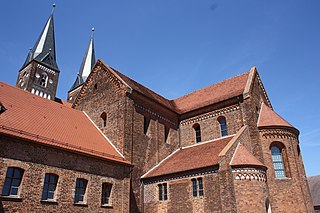
The Jerichow Monastery is a former Premonstratensian monastery located in the northern outskirts of Jerichow, near the shores of the Elbe River, in the state of Saxony-Anhalt of Germany.

Romanesque Revival, Norman Revival or Neo-Norman styles of building in the United Kingdom were inspired by the Romanesque architecture of the 11th and 12th centuries AD.
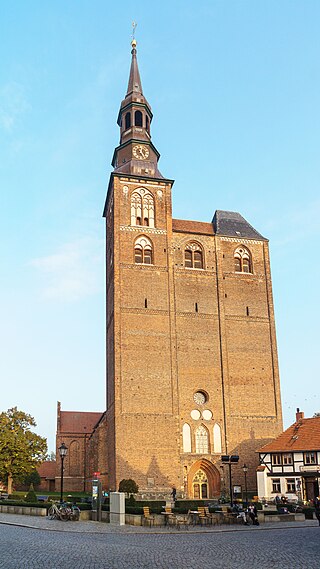
St. Stephen's Church is a Lutheran church in Tangermünde, Saxony-Anhalt, constructed in the Brick Gothic style typical of North Germany.




















